
Part IV: Initiation
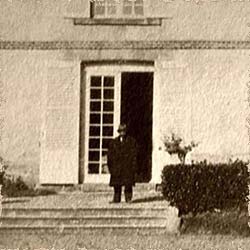
Gurdjieff at the Chateau Prieuré

And if Gurdjieff had started work with us such as we were, then why was he stopping it now?”i
[GLADYS ALEXANDER] “The scheduled program of the subjects to be taught at the Institute lay dormant, nor had those in quest of health found the cures they hope for, or perhaps believed in.” ii
[CHARLES NOTT] “Orage and I both felt that Gurdjieff might have explained more. And we both suffered very much inwardly at times and felt baffled and frustrated, as if we had been left… in mid air…” iii
A rift now forms between teacher and students, where they expect to be given more before being able to take the next step, while he expects them to have learned by now to stand on their own feet.
[GURDJIEFF] “I decided to close the Institute for many reasons. First of all, there are very few people who understand. I gave all my life for my Work, but the result from other people in general was not good and that is why I think it is not necessary for those few to sacrifice their lives here.” iv
[JOHN BENNETT] “Gurdjieff explained that the deeper changes we hoped for could not be brought about by the action of a third person, but must be the result of one’s own suffering and sacrifices.” ii

Gurdjieff at the Chateau Prieuré

The De Hartmanns at the Chateau Prieuré

The De Hartmanns at the Chateau Prieuré
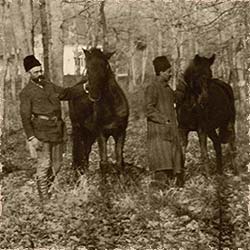
Gurdjieff’s Initiation
[GURDJIEFF] “The idea of initiation, which reaches us through pseudo-esoteric systems, is transmitted in a completely wrong form… Transitions from one level of being to another were marked by ceremonies of initiation. But a change of being cannot be brought about by any rites… There is not, nor can there be, any outward initiation… Systems and schools can indicate methods and ways, but no system or school whatever can do for a man the work that he must do himself…” i
What do we know about Gurdjieff’s own initiation?
We know he had traveled extensively. We know he had become intimately familiar with Buddhism, Sufism, and Christianity, probably through having joined monasteries of these orders. And then there is the elusive connection to the Sarmoung.

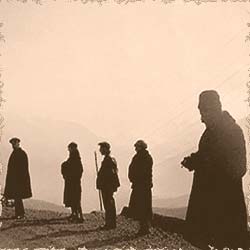



Sarmoung Brotherhood
The Seekers of Truth stumble upon rumors of a brotherhood founded in Babylon in 2500BC called Sarmoung. The brotherhood reputedly continued its activities in Mesopotamia uninterruptedly up to the 7th century AD. It was thought to have had in its possession the keys to many secret mysteries. At a further point in their search, the Seekers discover promising evidence that the Sarmoung might still be in existence. They determine to find it.
Gurdjieff doesn’t find the Sarmoung; the Sarmoung finds him. A representative of the order arrives in Bukhara with apparent foreknowledge of Gurdjieff, as if the Sarmoung had been monitoring his search. Blindfolded, and under an oath of secrecy, Gurdjieff and another member of the Seekers of Truth are taken on a few days journey and admitted to its chief monastery. There, they are surprised to meet a third member of their group, brought by the Sarmoung independently.
Gurdjieff on the Main Sarmoung Monastery
[GURDJIEFF] “The sheik of the monastery appointed as our guide one of the oldest monks… After this, we entered into the life of the monastery, were allowed access almost everywhere, and began gradually to find out about everything.” v
Gurdjieff recounts spending three months in the chief monastery of the Sarmoung. He is gradually admitted from its outer to its innermost courtyards and becomes exposed to its mysteries. In its innermost courtyard, he witnesses sacred dances of a remarkable level. He is shown some very old devices designed to help train dancers to perform these dances.
But he does not mention being ‘initiated’ during this visit to the Monastery, nor to any other monastery for that matter. Instead, Gurdjieff’s initiations happen alone, usually in moments of great inner turbulence, on the verge of despair, when forced to make a special effort to reconcile contradictions in himself.
Gurdjieff’s Epiphany
We know this from Gurdjieff’s own autobiographical accounts, the most poignant of which is featured in his book, Life is Only Real Then, When ‘I Am’. After having been injured by a stray bullet, he spends a long period of convalescence reflecting on his efforts at applying what he had learned from his searches so far, and is deeply disappointed.
[GURDJIEFF] “In spite of all my desires and endeavors, I could not succeed in remembering myself… even sufficiently to hinder the associations flowing in me.” vi
He has established the importance of self-remembering. But so far, he has limited success in achieving it. And then a new idea occurs to him. He realizes that in order to remember himself always and everywhere, he must create an alarm clock that will remind him always and everywhere. And he realizes that such an alarm clock can only be created through sacrifice. If he sacrificed a deep element in his psychology so that its absence would be constantly felt, it could serve as a permanent reminder.
[GURDJIEFF] “The question arises: What is there contained in my general presence which, if I should remove it from myself, would always… be reminding me of itself?” vi
This self-questioning happens alone. There is no teacher instructing it, no elder pointing out Gurdjieff’s chief identification, no experienced practitioner suggesting that he sacrifice it for the benefit of self-remembering. No audience. No ceremonial initiation. No outward recognition. At this point of his search, Gurdjieff has to be his own teacher. He has to use the self-knowledge he has acquired so far to delineate his chief weakness and the root of his falsehood. Then he must resolve to sacrifice it. His entire work so far has led to this point and so it is, indeed, a crowning moment; an initiation.
[GURDJIEFF] “Thinking and thinking, I came to the conclusion that if I should intentionally stop utilizing my exceptional power… of telepathy and hypnotism… then undoubtedly always and in everything its absence would be felt.” vi


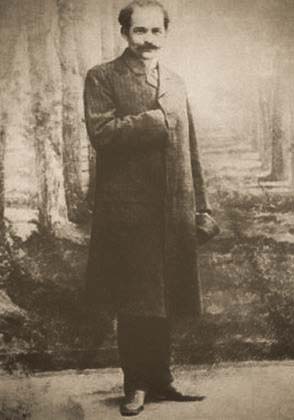
Gurdjieff as Professional Hypnotist (1908-1910?)
Gurdjieff’s Psychic Powers
Gurdjieff’s psychic powers, which seem to have been a latent tendency in him from childhood, and which he sharpened and developed throughout his travels, formed a big part of his charisma and magnetism, that remarkable impression reported by so many who met him for the first time:
[RENE ZUBER] “There emanated from Mr Gurdjieff such an impression of quiet strength that even animals sensed it…” vii
[ELIZABETH BENNETT] “His appearance was absolutely extraordinary. I had never seen anyone like that.” viii
[PAMELA TRAVERS] “His mere presence gave out energy…” ix
[RINA HANDS] “His eyes were full of life and he seemed to look directly at me with an expression of extraordinary sweetness…”
Now Gurdjieff realizes his psychic powers are a false enlightenment; a door that opens to one level but bars entry to the next. By vowing to give them up, he initiates an inner struggle. On the one hand, every situation will naturally invite their use. On the other hand, the vow to avoid them will restrain this impulse. Gurdjieff consequently affects a constant pull in opposite directions, a churning that generates the missing permanent reminding factor for self-remembering.
[GURDJIEFF] “As soon as I realized the sense of this idea, I was as if reincarnated; I got up and began to run around… without knowing what I was doing, like a young calf. It all ended thus, that I decided to take an oath… never again to make use of this property of mine.” vi
Such a sacrifice will differ from one person to another, but the general principle must remain the same and is portrayed on a colossal scale in Angkor Wat Temple. The churning scene is featured on a wall the divides between the first and second courtyards, serving as a door by which one can transition from the outer to the inner circle.
You could envision ceremonies of initiation centuries ago, where an initiate would be paraded from the first to the second courtyard through a causeway lined with flaming torches, to the sound of drums and chanting. But there is nothing ceremonious about Gurdjieff’s epiphany. He is alone, convalescing, apparently in great physical and emotional pain.
Which brings us back to the mysterious Sarmoung. By Gurdjieff’s description, their chief monastery is laid out in the form of four concentric courtyards, just like Angkor Wat. Might it be that his visit to this elusive brotherhood is allegorical? That Gurdjieff’s penetration to its holy-of-holies is his way of conveying the conclusion of his search symbolically, internally?

Gurdjieff as Professional Hypnotist (1908-1910?)
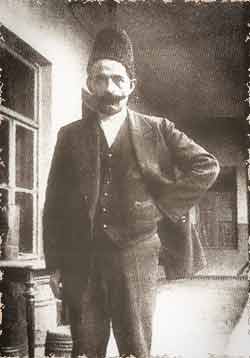
Gurdjieff in Kashgar (Early 1900s)
Messenger Overshadowing Message
Be that as it may, if there exists only self-initiation, and if Gurdjieff’s initiations always happen alone, then what could his students have expected from the Prieuré? He made every effort to arrange external situations conducive to inner struggle. He could only open the door; his student themselves had to step through. Gurdjieff’s charisma now turns to its opposite. The students have formed a dependence in their teacher that must first be overcome if they hope to achieve true initiation.
Sources
- In Search of the Miraculous by Peter Deminaovich Ouspensky
- Gurdjieff: Making a New World by John Godolphin Bennett
- Teachings of Gurdjieff: A Pupil’s Journal by Charles Stanley Nott
- Our Life with Mr. Gurdjieff by Thomas and Olga de Hartmann
- Meetings with Remarkable Men by George Ivanovich Gurdjieff
- Life is Only Real Then, When ‘I Am’ by George Gurdjieff
- Who are you Monseieur Gurdjieff? by René Zuber
- My Life: J.G. Bennett and G.I. Gurdjieff: A Memoir by Elizabeth Bennett
- P. L. Travers in an interview to the New York Times

Gurdjieff in Kashgar (Early 1900s)

Part I:
Gurdjieff
Part II:
The Teaching
Part III:
The School
Part V:
Fourth Way
